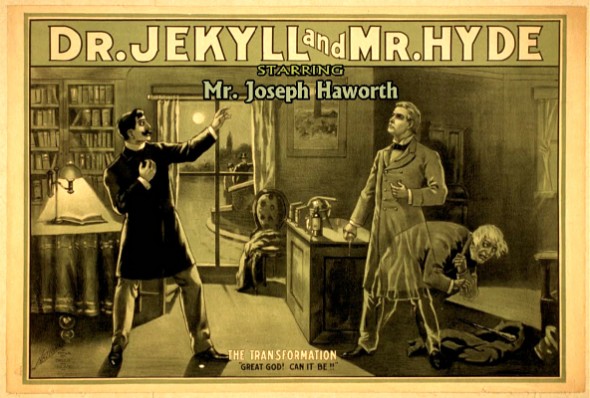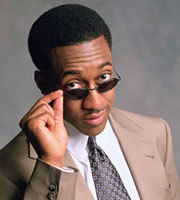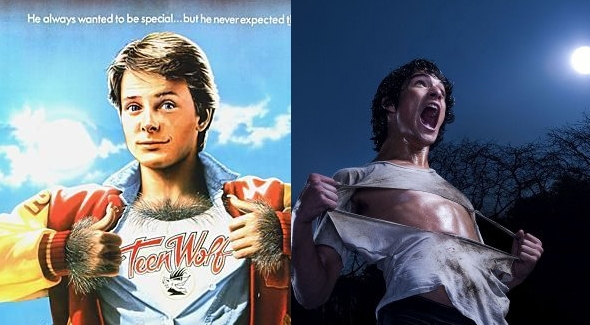4) Sexy Teenaged Dr. Jekyll and Mr. Hyde In Love

There are plenty of sexier Jekyll and Hyde images out there, just not work-safe ones.
This works out to be sort of the mirror image of the Frankenstein plot. This time, instead of building a perfect date, our teen chemistry whiz (we’ll make him a guy this time), is making a perfect version of himself. The obvious way to play this is to make the Jekyll character a dork, and the Hyde version impeccably cool. A slightly bolder and more interesting version would hew closer to Stevenson’s original vision, in which Jekyll isn’t trying to create an alter ego at all, but rather to repress his libidinous (and possibly homosexual) urges. That’s an impulse a lot of teenagers can relate to, I’m sure. One of the nice things about Jekyll/Hyde — well, one of the really problematic and gross things, in fact, but also one of the things that makes it a compelling story, is that Jekyll’s potion does seem to have the effects that he wants it to have, at least at first. He really does purify his “normal” persona. And in the versions where he’s provided with a love interest, she IS captivated by the new and improved Purity!Jekyll — there’s never a sense that completely repressing the Hyde persona was a bad idea in and of itself, even without the unexpected consequences. So translating this into highschool terms, you need a guy who feels like he could get his dream girl to like him if he wasn’t constantly distracted by how much he wants to have sex with her. He doses himself with Hormone-B-Gone, and it works! Not just as in “his urges go away,” but as in “he totally does get the girl.” Again, this plot is inherently kinky verging on creepy, since arguably what our teenaged Jekyll has done is to chemically delay the onset of puberty.
Step 1: Mr. Hyde.
Step 2: Sexy Hyde.
Step 3: Jekyll/Hyde is much less robust than some of the stories we’ve been looking at here. ALL it can really be “about” is mankind’s failed attempt to control the baser urges of its nature.
Step 4: To reverse this, we need a plot where mankind SUCCESSFULLY controls the baser urges of its nature.
Step 5: So we end up with a Jekyll/Hyde plot where eventually there is no Hyde. Rather, Jekyll creates a perfected super-serum that completely eliminates every unworthy human emotion. No bad side effects. Okay, maybe it makes you sparkle in the daylight. This being paranormal romance, I suppose it will have to turn out that lust is not an unworthy emotion (which is skirting pretty far afield from Stevenson’s original vision — but again, all you need is 25%).
Already kind of exists because:

And that’s all I have to say about that.
Now if you’ll excuse me, I need to get back to working on my own paranormal romance novel, tentatively titled “Sexy Teenaged Shark From Jaws In Love.” Hollywood, here I come!

I didn’t have time to read the whole piece, but in the spirit of the pedantry that Overthinking It champions, I would like to point out you used the word crapulence incorrectly. Also, the only worthwhile werewolf based entertainment is the MST3K version of the movie Werewolf.
Huh. I had always assumed it was a neologism from The Simpsons meaning “crappyness,” but it turns out to be a real word. You learn something new every day. Thanks, Chris!
I read the Twilight series, too, and I think I may have interpreted it slightly differently than you present in 3. and 5. on the first page. It seems like you’re implying Bella did nothing to get with and had no interest in Edward at all. But I beg to differ- she may not have walked up to him like a manic-pixie-dream-girl, but he was certainly the dominant topic for her thoughts from the moment she first saw him. She didn’t stalk him to the creepy extent he did her, no, but she was certainly obsessing over him, at the very least. I suppose for your purposes, 5. fixes things, but I don’t really think there’s a pre-destiny connection between Bella and Edward, so much as what eventually becomes unbridled lust and passion. (While the books are certainly rather maudlin, I do think the force-of-nature type description that I vaguely remember is, actually, quite apt. It was a random connection, but once made, it was totally unstoppable.) Jacob and the Renesme, yes, that whole imprinting thing is totally predestiny (and also pedophilic and a cop-out, ahem); but B and E don’t really have the deep-rooted “connection” both characters seem to think they have. It’s not her being or not being in the right/wrong place at the right/wrong time, it’s that they both lusted and by their powers combined, huzzah, makin’ teh vampyre baybeez.
How about The Little Mermaid? It has enough creepy/dark stuff going on (in the original), after all, aye?
1. Mermaid/merman
2. Sexy mermaid/merman (although I guess they’re already sexy, eh? I suppose if we went for a different version of merfolk to start with, like say the version from the Harry Potter series, where they screech instead of speak, mayhap… hm…)
3. I think it’s fair to say the Mermaid in the original is searching for herself. She doesn’t know who she is or where she belongs.
4. So instead, no, she knows exactly who she is and where she belongs: She loves him and needs to be by his side.
5. Perpetuating the notion that we are incomplete without a romantic partner in our life.
Another way to read the mermaid scenario is to turn it sort of into a classist commentary. So 3. Class differentiation 4. doesn’t matter, since she can fake it and pretend to be like him 5. which is problematic, because he doesn’t actually accept her for being different, he accepts a persona of sameness, which perpetuates the classist divides in society. This one could also be more about “identity,” too.
And I guess that sort of happened already with Splash, I just thought of it as I was about to post the comment. Poo.
Yeah, the Little Mermaid is pretty on point. Especially if you go past Hans Christian Andersen to the general folklore surrounding mermaids, where they’re supposed to lure sailors overboard with their sexuality, and drown them. What’s the reverse of that? Obviously the mermaid needs to be lured up on land by the dude’s sexuality. Which is exactly what happens. The message isn’t just “we’re incomplete without a romantic partner,” it’s “Hey ladies! Completely abandon your own life and dedicate yourself to a guy! And if he’s not into you, stalk him.”
(Full disclosure: I love The Little Mermaid, and think it’s heartwarming.)
So that made me think of sirens, and then satyrs. The latter would play out similar to the werewolves, wouldn’t it? Since satyrs are so… excitable… all the time. The satyr could do something similar to the one in the Percy Jackson books to blend in, just wear pants and sneakers; or maybe have some charm that makes his legs look normal to people not looking for it or some kinda jazz. So maybe he encounters a saucy minx that pursues him pretty fervently while he tries oh so hard to repress his urges, but she eventually gets him to let it all hang out and totally dominate her, perpetuating the notion that women must submit to their male partners because men know what’s best for them.
Actually, I bet the formula could be applied to a lot of Greco-Roman mythological creatures. New time waster for the day!
Just on a (underthunk) side note: mummies, or people completely wrapped in bandages, aren’t necessarily unsexy all the time. Take Shishio (Rurouni Kenshin/Samurai X series) as an example. I find him awfully, drop dead (no pun intended) sexy.
“I find him awfully, drop dead (no pun intended) sexy.”
It’s OK, you can intend the pun. This is a safe space.
For puns and for mummiephilia.
I was going to comment on how few female werewolves there seem to be in pop culture, but Latoya Peterson seems to have that covered.
However, I OverThought it a bit more. Lycanthropy is clearly linked to the monthly lunar cycle. Women also have a monthly cycle, which, in one stereotype, turns them into violently irritable beings at regular intervals. Has anyone attempted to link PMS to lycanthropy?
And survived? :)
Trying to close that tag…
Alan Moore’s Swamp Thing #40, “The Curse”
I forget what goes down exactly put I do remember it’s gruesome. The way he wrote made the idea feel obvious, probably a good thing, so I don’t know why the idea hasn’t caught on.
He also had underwater vampires in Swamp Thing, using some sound logic Moore figured that they don’t use oxygen and thus could live underwater, they had a whole city in a small towns lake.
In Terry Pratchett’s Discworld novels it’s pretty explicitly stated that way.
Yes. Justine Larbalestier’s excellent YA novel LIAR does this very well, including putting the teenaged narrator on strict birth control so as to prevent the change. (She lives in NYC, you see, which is perhaps not the best place for wild wolves to be loose.)
I mean, I did just give away the plot twist that occurs halfway through the book, but there was pretty much no other way for me to share this information, and also, I called that twist about 50 pages in, so it doesn’t ruin your enjoyment should you choose to read it!
Interestingly enough, all of my favorite pop-culture werewolf stories are centered around women. Ginger Snaps, mentioned in Peterson’s article, is a treatment of lycanthropy as a metaphor for female puberty — it’s not about menstruation in particular, but that’s part of it. The webcomic Family Man, which I’ve linked to (or at least tweeted about) before, is even harder to pigeonhole, but it’s still in the ballpark. Neil Jordan and Angela Carter’s The Company of Wolves is another good one, but that’s more of a Little Red Riding Hood story than a werewolf story, and I think all of the wolves are men anyway.
“Teen Paranormal Romance” is now a section at Barns N’ Noble. And I think it takes up three bookshelves. Back in my day, the Teen section was only three bookshelves.
On the topic of female werewolves, Anne Rice is very well-known, but not nearly as many people have heard of her (now late) sister, Alice Borchardt, who wrote my second favourite book of all time: The Silver Wolf. For one thing, there are at least three female werewolves in the book, for another, the main character is, herself, a werewolf. I’ve read it over ten times, and I’ve always wondered why Hollywood never picked up on it, but you know, women turning into wolves and ripping throats out, older courtesans who are strong and resourceful, the pope being said courtesan’s lover…too much for the status quo to handle I guess. Oh, and if the Bechdel test goes for books too, this totally passes it.
A beloved YA novel of mine is Blood and Chocolate. The film version was rather lack-luster, though. Anyhoo, it’s about a teenaged, female werewolf.
[Regarding Count Dracula] Then along comes this strange, unappealing man, who wants to do horrible things to them.
Are you sure we don’t want to read that as not just as patriarchal warning about the dangers of men, but as a particularly Victorian warning about the dangers of male foreign-types? Then the formula becomes:
1. Vampire
2. Sexy Vampire (shocker, I know)
3. Strange foreign men want to accost you (the ostensibly female and “English” audience) with unwanted sexual attention, stalk you, sexually assault you, and generally be inscrutably foreign in a way that will not only seduce you but also be strange and threatening and disturbing (and anti-Christian).
4. So instead, this sexy brooding vampire is the opposite of foreign and confusingly exotic, he’s overtly local, and like an old fashion Mormon boy in the Pacific Northwest, he doesn’t stick out at all.
5. And so a key part of the happy ending is that the sexy vampire doesn’t test cultural limits but rather embraces and epitomizes locally existing (if conservative) ideals. Because of that, when he wants to do odd and threatening things to his love interest (and of course it’s a heterosexual relationship, naturally), it’s okay because their brand of oddness is a vaguely familiar form of strangeness. This contrasts with the original creature, whose status as foreign exacerbated his unusual nature and therefore marked him as threatening.
Fright Night follows the classic Dracula formula pretty well, then – it’s about the threat of a fully realized womanizer/vampire who is after you mom and girlfriend. That’s part of the nice tensioin it, which I didnt get until now. Only he’s also The Sexy.
Ooh, I wanna have a go at this, and while “Young Elder Gods in Love – or All is Fair in Love and Craft” would make for an interesting title, and I’m sure there are people out there who have a thing for non-euclidean bodies, that sort of thing has already been done to death (and almost to the point where even death may die). Let us instead try:
1) Zombies.
2) Hawt zombies. This is going to be tricky, but let’s say, rather than following the standard post-mortem procedure of rotting and slowly falling to pieces (and, you know… walking around and craving brainsss), our zombies merely turn into pale, skinny things with a sort of “romantic”, brooding, distant look on their faces. Probably they wear a lot of black, and lots of dark eyeshadow for zombies of both sexes (in a totally heterosexual sort of way).
3) Obviously, the contemporary zombie story is one of disease, which clearly resonates well with our collective fear of bird-/swine-/creepy Asian foreigner-flu, weaponised computer viruses and “viral” political extremism, shock videos and what have you.
All the same, the disease theme is a little to icky and physical for your standard family friendly paranormal romance. The zombie myth does however embody another theme which is – oh teh ironiez – universally relatable to teenagers everywhere: the fear of conformity.
4) This one practically writes itself, given how we have chosen to hunkify the zombies; clearly they are the “alternative” clique, and we – cue angsty pseudophilosophical musing – are the real, conformist, zombies (or if you prefer “No John, you are the demons!”).
5) Well, I’m sure the edgy non-conformist zombies can find their place within our social mores as long as they don’t engage in anything more subversive than wearing black and looking brooding, also our zombie Cullen expy would be every bit as reluctant as the original to bite the heroine and drag her with him into the dark, dangerous world of… wearing black and looking brooding. And when he finally does, the lesson to be learned is simply that it is perfectly all right to rebel against the norms of society, as long as one subscribes to the social norms for doing so.
Also: isn’t it about time that teenage girls get to fantasise about a guy who’s interested in them for their brains?
Has it been done to death? I am actually intrigued here.
1. Elder God
2. Hawt Elder God. Despite the obvious existence of someone, somewhere into non-euclidean horrors (and the burgeoning population of tentacle fetishists on the internet) I’m going to go with a Nyarlathotep sort of abomination here, who interacts with mortals and to do so manifests in humanish form, even if that form is anywhere from slightly eerie to makes-one-mad-to-gaze-upon-his-beauty.
3. Obviously, the basic fear underpinning the Cthulu mythos is our absolute insignificance in the vast tremors of the apathetic cosmos. Therefore –
4. In All’s Fair in Love and Craft, we really *are* the center of the universe; our actions matter on a cosmic scale. The mortal human POV/audience stand-in/Designated Love Interest character really *does* catch the attention and affection of this ancient and unspeakably powerful being connected to the most fundamental workings of the universe, and furthermore, her actions could have terrifying repercussions for her civilization/planet/galaxy if she slights him, or even simply gives him the wrong butterfly painted coffee mug, or whatever, which is it’s whole own kind of terrifying.
5. This one *is* incredibly easy, now that I think about it. Instead of being a harrowing parable about the ways men with power can abuse that power to scare and pressure women, it turns out that Nyarla-expy really *does* love his super-special human cupcake in ways that fulfill human romantic expectations, and furthermore the Power of True Love persuades him to ensure that Earth is protected from the accidental sleep rumblings of the other Great Old Ones. With relevance in the cosmos comes great responsibility, but of course Our Heroine will use her power for Good, which really does have some meaning after all. This also plays nicely into skeevy societal myths about women using their sexual allure to manipulate men in power, despite how completely opposite the power dynamic at play really is. Anyway, they get a Happily Ever After, with Our Heroine’s triumphant ascension to psuedo-godhood and/or honeymoon tentacles optional.
Already exists because: …wow, you’re right, it HAS been done to death. Just about every angel and/or demon falling in love with a human story runs along these lines, usually with a malicious apocalypse to prevent in tow. Not really my genre, so I can’t give specifics, but I’ve definitely seen the format around. And the whole Cole storyline in Charmed is totally this, with more dramatic ups and downs for serial suspense’s sake. Damn.